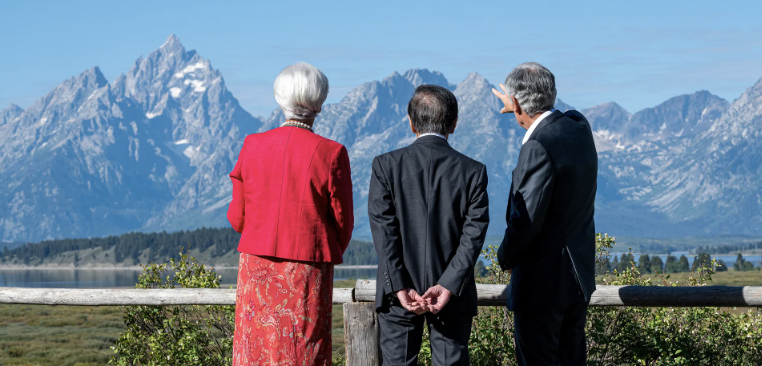Officials from three of the world’s leading central banks announced on Friday that they are firmly on track to lower—or continue lowering—interest rates in the coming months. This marks the beginning of the end of an era of high borrowing costs as the global economy gradually escapes the grip of post-Covid inflation.
“The time has come for policy to adjust,” stated Federal Reserve Chair Jerome Powell at the annual meeting of policymakers and global economists in Jackson Hole, Wyoming, effectively committing the U.S. central bank to a rate cut when officials convene in September.
Setting a precise start date for the Fed and aligning numerous major central banks towards the same direction has eased some investor concerns. However, considerable uncertainty and risks remain. Powell and his counterparts could have clarified the speed at which they plan to lower rates in the coming months. Meanwhile, emerging weakness in labour markets and overall growth is replacing inflation as the primary concern for policymakers.
Clearly, the focus has turned to the FED’s second mandate: the employment market. Indeed, unlike numerous central banks, the FED has two mandates: price stability and maximum growth. Powell issued a strong call to support the job market. He cited the recent rise in unemployment to nearly 4.3%, its highest level in three years, describing the slowdown in the labour market as “evident” and adding that central banks would not tolerate further increases.
“We will do whatever we can to support a strong labour market as we move towards price stability,” he said.
A study presented at the Jackson Hole conference warned that the U.S. labour market is approaching a tipping point and that policymakers risk a much more significant increase in unemployment if the slowdown continues.
However, things are more complex. “The direction of travel is clear, and the timing and pace of rate cuts will depend on incoming data, evolving outlooks, and the balance of risks,” Powell remarked during the Fed’s annual economic symposium in Jackson Hole. But no clear path has been mentioned. Before the meeting, investors forgot that two interest rate cuts were in the FED projections updated in June.
Over the four years since the Fed last overhauled its monetary policy framework, the world has witnessed an unprecedented global pandemic, historic fiscal stimulus, and multiple geopolitical crises, all of which have pushed inflation to its highest levels in four decades.
Powell has admitted that the Fed was slow to raise interest rates in 2022 because he and his colleagues misjudged the persistence of inflation. Since then, much of the debate has centred on whether the changes made to the monetary policy framework in 2020 bear some responsibility for this delay.
At the Fed, officials will likely examine closely how they approach each of their Congressional mandates—low inflation and maximum employment. The framework unveiled in 2020 was shaped by the moment: millions of people had just lost their jobs, and inflation remained moderate after years of undershooting the 2% target.
This context led to two significant changes. First, the central bank would aim for slightly above-target inflation after periods of below-target inflation. Second, it would only respond when the unemployment rate exceeded what it considered a neutral level but not when it fell below it.
This latter change marked a significant departure from the longstanding approach where the Fed would begin tightening monetary policy during periods of low unemployment to prevent any potential inflationary pressures from an overheating labour market.
With inflation nearly back to the Fed’s target and rising concerns about unemployment, the central bank is poised to begin cutting rates in September. This raises questions about how quickly the Federal Reserve will need to ease rates and where they will ultimately settle. In addition, given the current geopolitical situation, a new shock on energy and commodities prices is not out of the question, which could reshape the Fed’s monetary policy.
In addition to Powell, several European Central Bank’s Governing Council members attended the discussion, taking in the breathtaking scenery of Grand Teton National Park. Olli Rehn of Finland, Martins Kazaks of Latvia, Boris Vujčić of Croatia, and Mário Centeno of Portugal indicated their support for another interest rate cut next month—following a historic reduction in June.
Eurozone policymakers appear increasingly concerned with growth, which has faltered after a solid first half. They also signalled worries about weakening labour markets and less about inflation, even though the ECB’s mandate does not include employment.
ECB officials are forming a consensus around two more cuts this year, including one in September, provided that inflation remains aligned with the bank’s projections, which foresee it falling to the 2% target by the second half of 2025.
Bank of England Governor Andrew Bailey was also scheduled to speak at Jackson Hole on Friday. In prepared remarks released before his speech, he indicated that he was open to further rate cuts, stating that the risks of persistent inflation appeared to be receding.
The Bank of England recently lowered its benchmark lending rate by a quarter-point earlier this month to 5%, marking its first reduction since the pandemic began.
Central banks in Canada, New Zealand, and China have also eased monetary policy elsewhere. The notable exception is Japan, where officials began their first tightening cycle 17 years ago.
